
Feeding roots to animals
The last chapter
of $10
Root Cellar
is full of tips for growing and using root vegetables.
During research for the book, I was fascinated to learn that
the popularization of turnips spurred a culinary revolution
during the Middle Ages because the roots provided enough
supplemental feed to carry cows, pigs, and other animals
through the cold months. Previously, farmers had to dry
off dairy animals and slaughter all but the breeding stock
among meat breeds as soon as cold weather hit since there
wasn't enough grass to bring their animals through the
winter. After the turnip revolution, though, farmers
added fodder beets, rutabagas, mangels, carrots, parsnips, and
potatoes to their livestock gardens, and meat and dairy became
a larger part of the year-round diet.
Although cheap
grain has made roots fall out of favor as modern livestock
food, one of my
favorite bloggers grows roots to feed her dairy cow over the
winter. Nita and her family grow most of their own food
on 180 acres in the Pacific Northwest, depending on rotational
grazing to feed their beef cows over the winter.
However, as Nita notes, "A dairy cow is a horse of a different
color nutrition- and production-wise." Dairy cows need
supplemental nutrition during the winter, and that supplement
usually comes in the form of grain.
"I only had to
look back in history a little ways to get away from grain,"
Nita explained. "We [started] looking for roots that would suit
multiple species, namely us, the family cow, and the laying
hens. All of the root crops we chose would work well for
sheep, goats, and rabbits too. The roots that we settled
on were carrots, beets, parsnips, and rutabagas. We had
grown mangels (fodder beets) before, but found that they were
large and because a large portion of the root grows above
ground, they did not meet our criteria for easy storage.
The only references I have seen concerning problems is for
feeding beets and mangels to rams and wethers. Some
believe mangels and sugar beets can cause calculi in the
kidneys and bladder."
Every farmer
tends to develop favorite root crops to match their specific
growing conditions and their livestock's needs. In Feeding Poultry, Gustave Heuser
recommends giving 0.04 to 0.05 pounds of mangels, carrots,
turnips, rutabagas, or potatoes to each chicken per day as a
supplement to their regular diet. John Seymour prefers
feeding rutabagas and fodder beets to his livestock, while
Nita usually provides her milk cow a mixture of carrots,
parsnips, and beets. She grows Red-cored Chantenay
carrots, Harris Model or Andover parsnips, Lutz/Winterkeeper
beets, Laurentian or Joan rutabagas, and Golden Eckendorf or
Colossal Long Red mangels for animals and humans, along with
Jerusalem artichokes, celeriac, and daikon or salad turnips
for the table. "Brassicas are a no-no during lactation
unless you want cole-flavored milk," she warns.
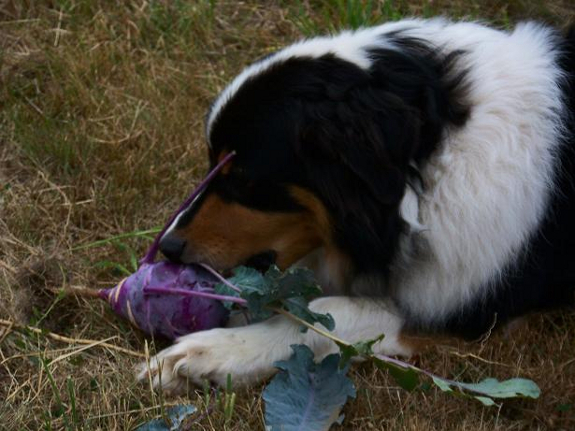
 Nita uses a
mechanical chopper to cut up the five pounds of mixed roots
she provides for her dairy cow each winter day. She
notes that the chopper processes the day's roots in one
minute, versus five minutes with a knife. Alternative
methods for processing roots for livestock include cooking
(essential when feeding potatoes to non-ruminants like pigs
and chickens), grating, or feeding whole and raw.
"While the roots
won't replace all the grain for your stock, they can play a
bigger part of their winter diet, giving variety and giving
you more control in what you are feeding your animals," Nita
concluded. "Growing and harvesting roots has made us
feel closer to our goal of self-reliance. And we find as
we eat more of these types of in-season vegetables ourselves,
we rely less on labor- and energy-intensive food-preservation
methods. While I'm not giving up my canning and
freezing, I find that I'm storing less food that way, and
actually providing more variety in our meals."
$10
Root Cellar is free today on Amazon, so download
your copy now! If you can't figure out the apps allowing
you to read kindle ebooks on your computer or other device,
you can also email me
today for a free pdf copy. Thanks for reading!
Nita uses a
mechanical chopper to cut up the five pounds of mixed roots
she provides for her dairy cow each winter day. She
notes that the chopper processes the day's roots in one
minute, versus five minutes with a knife. Alternative
methods for processing roots for livestock include cooking
(essential when feeding potatoes to non-ruminants like pigs
and chickens), grating, or feeding whole and raw.
"While the roots
won't replace all the grain for your stock, they can play a
bigger part of their winter diet, giving variety and giving
you more control in what you are feeding your animals," Nita
concluded. "Growing and harvesting roots has made us
feel closer to our goal of self-reliance. And we find as
we eat more of these types of in-season vegetables ourselves,
we rely less on labor- and energy-intensive food-preservation
methods. While I'm not giving up my canning and
freezing, I find that I'm storing less food that way, and
actually providing more variety in our meals."
$10
Root Cellar is free today on Amazon, so download
your copy now! If you can't figure out the apps allowing
you to read kindle ebooks on your computer or other device,
you can also email me
today for a free pdf copy. Thanks for reading!
This
post is part of our $10
Root Cellar lunchtime series.
Read all of the entries:
|
Want more in-depth information?
Browse through our books.
Or explore more posts
by date or
by subject.
About us:
Anna Hess and Mark Hamilton spent over a decade living self-sufficiently in the mountains of Virginia before moving north to start over from scratch in the foothills of Ohio. They've experimented with permaculture, no-till gardening, trailersteading, home-based microbusinesses and much more, writing about their adventures in both blogs and books.
Want
to be notified when new comments are posted on this page? Click on the
RSS button after you add a comment to subscribe to the comment feed, or simply check the box beside "email replies to me" while writing your comment.

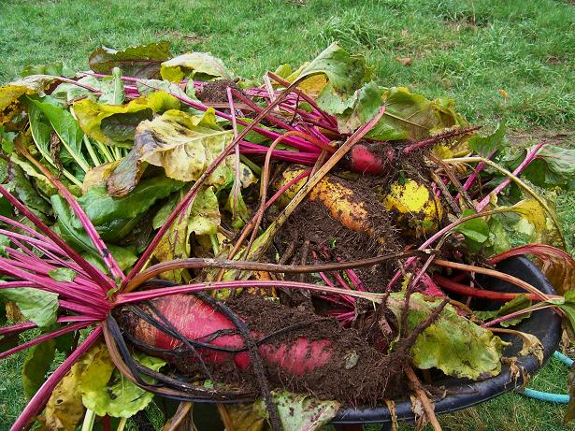

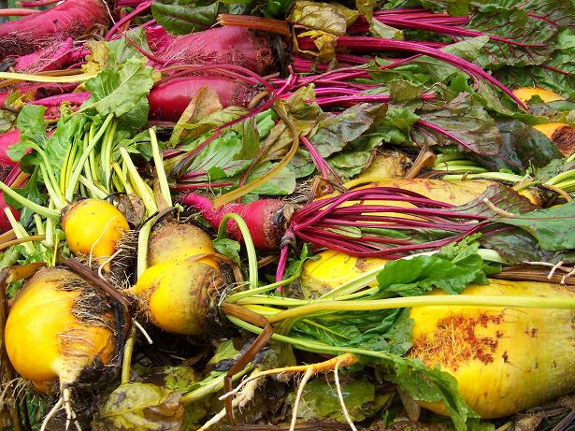
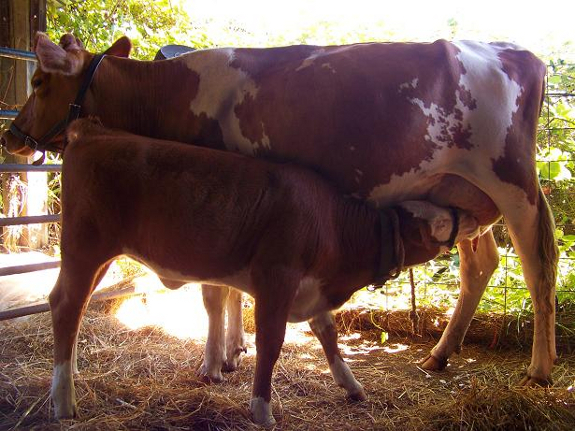

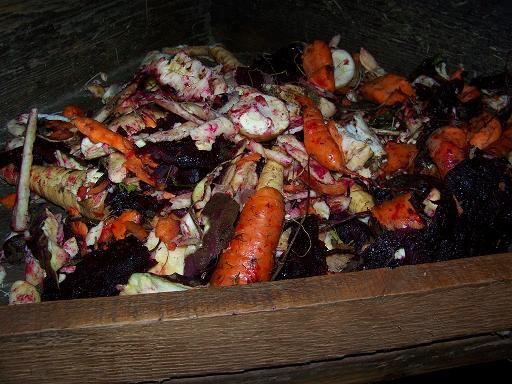
 Nita uses a
mechanical chopper to cut up the five pounds of mixed roots
she provides for her dairy cow each winter day. She
notes that the chopper processes the day's roots in one
minute, versus five minutes with a knife. Alternative
methods for processing roots for livestock include cooking
(essential when feeding potatoes to non-ruminants like pigs
and chickens), grating, or feeding whole and raw.
Nita uses a
mechanical chopper to cut up the five pounds of mixed roots
she provides for her dairy cow each winter day. She
notes that the chopper processes the day's roots in one
minute, versus five minutes with a knife. Alternative
methods for processing roots for livestock include cooking
(essential when feeding potatoes to non-ruminants like pigs
and chickens), grating, or feeding whole and raw.
Very interesting bit of history about turnips & livestock. Thanks for the info.
Shredded beet pulp costs about $15 for a 50 lb bag at the feed store. A dairy cow can be given up to 10lb/d. Gotta wonder if all the work & expense involved in growing and processing your own is worth it vs buying it?
Great post Anna! Thanks for the link!
Doc, the only reason to stay away from the convenience of shredded beet pulp for feed is that the product is from GMO beets. If you don't care about the GMO issue in feed, or the heavy pesticide use in conventional crops and strictly look at this as a labor equation, then yes for sure the bagged beet pulp by-product is much easier, only requiring cash and some forethought to soak before feeding.
We grow our own food so we can control some of these issues in our personal food supply. From a labor standpoint with the milk cow, it's much, much easier to pickup a gallon of milk at the store or a pound of butter too, but this all works with our landscape and suits our situation, but it definitely is not for every homesteader or farmer. http://non-gmoreport.com/articles/jun08/sugar_beet_industry_converts_to_gmo.php
Nita: I completely understand and sympathize with your POV (We won't get into the GMO/chemical thing. I never like to argue religion
Let's face it: any city dwelling welfare recipient has a higher standard of living than any homesteader when evaluated strictly on the time/money/labor scale. It's the intangibles associated with growing your own & living liberated that are priceless.
And when the SHTF, as the preppers say, we'll still have our food security.
and I stumbled on your blog while researching feeding swede and carrot to cows. You say use have a mechanical chopper. I don't suppose they are still being made. On the hunt! Cheers, Dave
Craigslist score! Thompsons banner root chopper. Close to home, working condition, cheap.